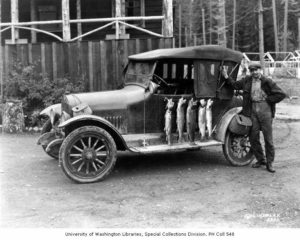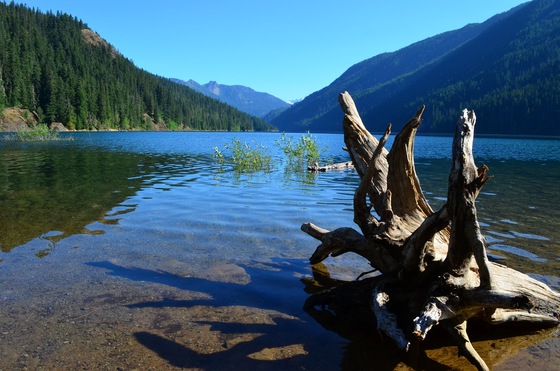IS IT A LAKE?
(Or a reservoir?)
Big Kachess Lake (400 ft. deep) and Little Kachess Lake (195 ft. deep) were created by giant glaciers over thousands of years. In 1911 an earthen dam was placed at the outlet of Big Lake Kachess, raising the water level approximately 60 feet. This joined the two natural lakes and created a single body of water known as Lake Kachess. It also permanently destroyed an ancient salmon run and endangered other fish species (e.g., Bull Trout).
The additional water created by the earthen dam has been regulated as a reservoir, to the benefit of downstream irrigators since 1915.
Literal Native American Meanings: Kachess “more fish” and Keechelus “few fish”

The truth is, the water in Lake Kachess is divided into both a lake and a reservoir; the original, glacier-created water (about 80% of the total water) is a natural lake, and the top 20% is a man-made, regulated reservoir.
Today, more than 100 years after the reservoir was added, Lake Kachess is under siege by special interests in the Yakima Basin. If the proposed Kachess relief pump plan succeeds, the ratios would be treated as 40% reservoir and 60% natural lake, thus draining the lake well below ancient levels, most of the lake would likely be inaccessible due to steep grades. Water flow from Little Kachess to Lake Kachess would completely stop. The controversial plan would build a huge pumping plant that would drain water from the glacial-created natural lake (not the reservoir), the diesel pumps would further contribute to environmental pollution and disrupt the forest with noise pollution. With no water flow from Little Lake Kachess, bull trout would not be able to travel to spawning areas, further contributing to their extinction in Lake Kachess. The plan would permanently damage the beauty of the natural lake, “dewater” private and public wells, negatively impact private property values, eliminate recreation opportunities for tens of thousands of people annually, reduce tax revenues that support public services in Kittitas County, increase risk of wildfires and waste millions of taxpayer dollars. (this plan caters to big farms in the Yakima Lower Valley, many small farmers are against this proposed plan)
The proponents know the public would resist any effort to destroy natural, glacial-built lakes for the benefit of a small group of special interests. But they also know that, if they can confuse, mislead, and deceive the public by re-naming a natural lake a reservoir, their task will be easier. Here are some examples from the current Supplemental Draft Environmental Statement (SDEIS) showing how they intentionally misrepresent the facts and deceive the public:
Change the names
Natural Lake………….becomes “dead storage”
Big Kachess Lake……becomes “drought relief pool”
Lake Kachess……..….becomes “Kachess Reservoir”
Lake Keechelus………becomes “Keechelus Reservoir”
Big Kachess Lake……becomes “Big Kachess”
Little Kachess Lake…becomes “Little Kachess”
In addition, they ignore or misrepresent the costs, overstate the benefits, and exclude affected citizens from being part of the process. They know that if this deception succeeds with Lake Kachess, it is a strategy they can use in other locations. A similar collection of special interests is already planning to drain water from the Icicle River Basin in Washington State.
In summary, the Yakima Basin Integrated Plan (YBIP) proposal for a Kachess Drought Relief Floating Plant (KDRPP) is an attack on a natural, glacier-built lake. It has nothing to do with a reservoir; every drop of water will be taken from a natural lake.
What can you do? Contact your elected representatives (Federal, State and Local) to let them know you oppose the YBIP’s effort to drain water from our two natural lakes: Lake Kachess and/or Lake Keechelus and SIGN THE PETITION
